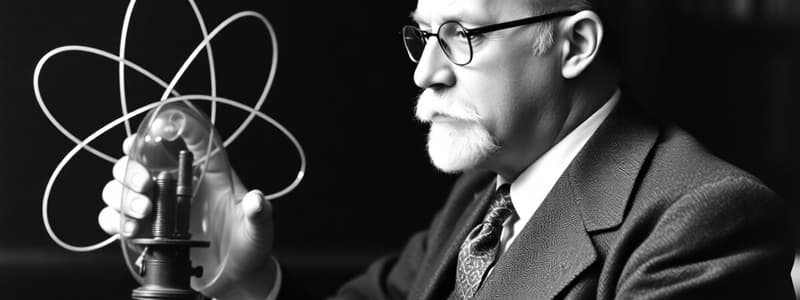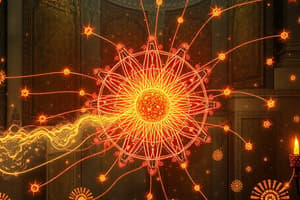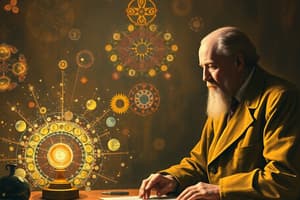Podcast
Questions and Answers
Which discovery made by Rutherford surprised him by leading to a Nobel Prize in Chemistry?
Which discovery made by Rutherford surprised him by leading to a Nobel Prize in Chemistry?
- The development of the cyclotron
- The identification of the electron
- The discovery of X-rays
- The disintegration of elements and identification of alpha and beta radiation (correct)
In what year did Rutherford propose his model of the atom, featuring a central nucleus orbited by electrons?
In what year did Rutherford propose his model of the atom, featuring a central nucleus orbited by electrons?
- 1908
- 1911 (correct)
- 1899
- 1919
What significant achievement did Rutherford make in 1919 in the field of nuclear physics?
What significant achievement did Rutherford make in 1919 in the field of nuclear physics?
- Splitting the atom and discovering the proton (correct)
- Identifying the neutron
- Formulating the theory of radioactive decay
- Discovering gamma radiation
Where did Rutherford conduct the research that led to his Nobel Prize?
Where did Rutherford conduct the research that led to his Nobel Prize?
What type of radiation did Rutherford determine to be composed of positively charged particles?
What type of radiation did Rutherford determine to be composed of positively charged particles?
Who recommended Rutherford for the professorship at McGill University?
Who recommended Rutherford for the professorship at McGill University?
Which scientist's discovery of radioactivity preceded Rutherford's work on radiation?
Which scientist's discovery of radioactivity preceded Rutherford's work on radiation?
What fundamental particles were already known when Rutherford was conducting his research at McGill?
What fundamental particles were already known when Rutherford was conducting his research at McGill?
What elements were involved in Rutherford's first successful transmutation experiment?
What elements were involved in Rutherford's first successful transmutation experiment?
What did Rutherford observe being emitted through a window during his transmutation experiment?
What did Rutherford observe being emitted through a window during his transmutation experiment?
Flashcards
Ernest Rutherford
Ernest Rutherford
A physicist who significantly advanced atomic theory and discovered radiation types.
Alpha and Beta Radiation
Alpha and Beta Radiation
Types of radiation identified by Rutherford during his studies of atomic disintegration.
Nobel Prize in Chemistry 1908
Nobel Prize in Chemistry 1908
Award won by Rutherford for his work on the disintegration of elements and radiation.
Rutherford model of the atom
Rutherford model of the atom
Signup and view all the flashcards
Discovery of the proton
Discovery of the proton
Signup and view all the flashcards
Nuclear Fission
Nuclear Fission
Signup and view all the flashcards
Transmutation of Elements
Transmutation of Elements
Signup and view all the flashcards
Rutherford's scholarship at Cambridge
Rutherford's scholarship at Cambridge
Signup and view all the flashcards
Radiation emitted from uranium
Radiation emitted from uranium
Signup and view all the flashcards
Quote: 'touched the ghost of matter'
Quote: 'touched the ghost of matter'
Signup and view all the flashcards
Study Notes
Ernest Rutherford
- Born into a farming family in Brightwater, New Zealand (1871)
- Earned degrees at Canterbury College (now the University of Canterbury)
- Won a scholarship to study at Cambridge University under J.J. Thomson
- Became a professor of physics at McGill University, Montreal (1898) @ 27
- Nobel Prize in Chemistry (1908) for work on radioactivity
- Found atoms were not indivisible and contained smaller, charged particles
- Discovered alpha and beta radiation, and that alpha radiation was made up of positively charged particles. This meant disproving the idea of atoms being indivisible.
- Developed the "Rutherford model" of the atom in 1911
Rutherford's Discoveries
- Discovered alpha and beta radiation, both types of radioactive emissions
- Demonstrated the disintegration of elements (radioactivity)
- Determined that alpha radiation consisted of positively-charged particles
- Discovered the proton in 1919 and transformed one element into another (nuclear fission)
Atomic Structure
- Proposed the Rutherford model of the atom in 1911
- Stated that electrons orbit a tiny nucleus, similar to the structure of the solar system
- Demonstrated that atoms are made up of smaller parts, including protons and electrons
Studying That Suits You
Use AI to generate personalized quizzes and flashcards to suit your learning preferences.





